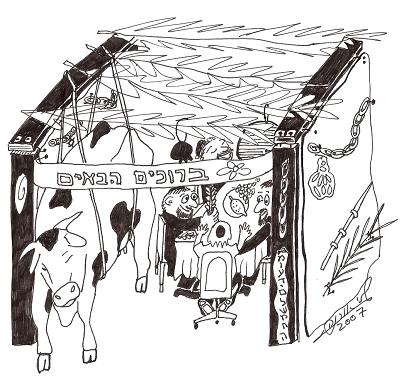
The early sages (the Tanaaim) disagreed about the law regarding a sukkah built on the back of a camel. According to one sage, Rabbi Meir, it would be permissible, while according to another sage it would not be. The scholars explained the reason for the disagreement: the sage who disqualifies a sukkah on the back of a camel is of the opinion that a sukkah must be suitable for use all seven days of the holiday, and since on the Sabbath and on a festival day one may not sit atop a camel (the sages forbade riding animals on the Sabbath and on festival days), the sukkah is suitable for use on only the five intermediary days. “You shall observe the Feast of Tabernacles seven days” (Deuteronomy 16:13) — a sukkah suitable for seven days is called a sukkah, one which is not suitable for seven days is not called a sukkah.” According to the sage who permits this sukkah, since according to the laws of the Torah one is permitted to ride an animal on the Sabbath and on festival days this sukkah is suitable for use on all seven days, though the laws of Chazal make it unsuitable. The sages also disagreed about the validity of a sukkah in which one wall is an animal. According to one sage this sort of sukkah is unsuitable and according to another it is permissible. The scholars explained the reason behind the invalidity: one of the scholars, Abaye, thought that this sukkah is invalid because if the animal were to die during the holiday a sukkah wall would be missing, and this would make the sukkah invalid. Another scholar, Rav Zira, thought that this sukkah would be invalid because the animal might run away in the middle of the holiday, leaving the sukkah lacking a wall and thus invalid. The scholars clarified their thoughts and gave greater detail. If the animal were very large and tied down well, for example an elephant tied well, it would not be able to run away and if it died, it would still be large enough to serve as a sukkah wall; according to all, this sort of sukkah is valid. The above disagreement amongst the sages concerns an untied elephant. According to the scholar who feared the animal might die, an elephant invokes no such fears because even if it does die, its body is still large enough to serve as a sukkah wall. According to the scholar who feared the animal would run away, since the elephant is not tied it very likely will flee, and so the sukkah is invalid. The scholars asked: If the elephant is not tied down, why is the sage who fears the animal may die not worried that the elephant may run away while not tied down? The likelihood is that an unrestrained elephant will run away. The scholars recanted and argued that according to all sages a sukkah including an unrestrained elephant is invalid, and their disagreement was about a small restrained animal, one whose corpse would not serve as a sukkah wall due to its negligible size. The scholars then asked: A sukkah which has as a wall an animal should be invalid because the animal’s body does not serve as a substitute for a partition, as there is air space between its belly and the ground. Answer: The air space must be filled with branches and twigs. The scholars continued to ask: Perhaps the animal will decide to rest, and in its resting position its height will be less than the meter required for a sukkah wall. Answer: The animal must be tied with ropes coming up from under its belly so it cannot rest and lie down. The scholars then asked: If we must tie it so it cannot lie down, why did the sage above fear the animal would die? Even if it did die, the ropes would hold its corpse in place and it could serve as a wall. Answer: Since there are animals whose heights do not exceed 70 centimeters, and since the height of a sukkah wall must be a meter, the difference is made up by involving a Halachic principle which sees the part as though it were the whole, a principle called lavud. If the animal were to die we would fear that the corpse would bend toward the ground due to weight and the person sitting inside the sukkah would not notice. In such a case we must fear that the air space constituting the difference between the corpse’s height and the required meter will exceed 30 centimeters and the Halachic principle seeing the part as the whole will not apply, as it is only applicable for a space of 30 centimeters or less.
(Babylonian Talmud, Tractate Sukkah 23a-b)
